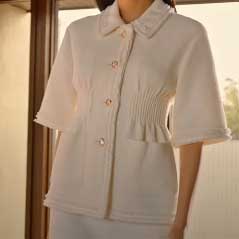St. John is an American luxury fashion brand that is known for its elegant, timeless designs and premium fabrics. But with price tags often reaching four figures for a single item, St. John clothing does not come cheap.
There are several reasons why St. John commands such high prices compared to other retailers. Understanding what goes into making St. John’s luxury apparel sheds light on why devotees of the brand find it worth the splurge.
Reasons For St. John Clothing Being So Expensive
Here is a list of such reasons:
A Commitment to Quality Materials
- Complex Construction for a Perfect Fit
- Low Production Volumes
- A Powerful Brand Image
- Extensive Brand Heritage
- Made in America
- High Overhead Costs
Let’s explain those points.
A Commitment to Quality Materials
One of the biggest factors behind St. John’s lofty price points is the exceptional quality of materials used. St. John sources premium fabrics from around the world to craft its garments. These include:

- Italian wool – St. John uses ultra-fine merino wool woven in Italy for its iconic knitwear. The wool offers an impeccably smooth feel and holds its shape well.
- Silk – Luxurious silk sourced from China and Italy goes into St. John’s dresses, blouses, and other silky pieces. The fabric drapes beautifully and has a subtle luster.
- Cashmere – Soft, warm cashmere from goats in Mongolia and China gets made into St. John’s cashmere knits and coats. It’s exceptionally lightweight and soft.
- Cotton – High-end cotton with long staple fibers from the United States and Egypt gets spun into lightweight knits and wovens. It has a smooth, supple handfeel.
- Leather – St. John uses extremely soft, lightweight lambskin leather from New Zealand and Italy for jackets, skirts, and accessories. It molds to the body and wears well over time.
Only the finest, most flawless fabrics make the cut to become St. John garments. The incredible quality of the raw materials shines through in the finished products.
Complex Construction for a Perfect Fit
It takes expert technical construction to translate St. John’s first-class fabrics into polished pieces with an impeccable fit. The brand uses advanced techniques like:
- Knit-to-shape – St. John knitwear is produced using specialized machines that knit tubes of fabric directly to the shape of the garment pattern. This creates a seamless interior and excellent drape.
- 3D pattern engineering – Computer-aided design allows St. John to digitally develop patterns with precise shaping for the female form. The patterns get perfected over multiple test garments.
- Bias cut – Many St. John dresses and skirts utilize bias cut fabrics, which follow the natural diagonal grain for enhanced fluidity, drape and comfort in motion. It’s a complex technique.
- Interior corsetry – Shapewear-like interior construction with flexible boning, zippers and hook-and-eye closures allows a made-to-measure fit.
- Hand finishing – Details like buttonholes, embroidery, beading and lace trim get meticulously executed by hand by skilled craftspeople.
St. John pours tremendous resources into achieving styles with a tailored yet ultra-flattering silhouette. This accounts for much of the brand’s elevated pricing.
Low Production Volumes

St. John keeps inventory tight by producing only small batches of each style.
While fast fashion brands churn out tens of thousands of nearly identical pieces, St. John may make just a few hundred of a given design.
This low production volume allows St. John to focus immense care into the construction process.
But it also means the overall output is a fraction of major fashion labels. Spreading costs over fewer garments leads to higher per-item pricing.
Limited availability also keeps St. John designs exclusive. Having fewer customers own the same piece adds to the brand’s luxury appeal.
A Powerful Brand Image
A brand’s reputation and status have a significant impact on pricing power. And over its nearly 60 years in business, St. John has cultivated an extremely powerful luxury image.
Headquartered in glamorous Southern California, St. John exudes an elite sensibility inside its glossy retail stores. The company has built associations with style icons like Angelina Jolie and Gwyneth Paltrow through selective endorsements and placements. St. John is designed to appeal to wealthy, fashion-forward professional women with refined tastes.
This cultivated prestige enables St. John to command aspirational prices in line with the most exclusive names in fashion. Customers pay for the status and recognition gained from wearing the brand’s designs.
Extensive Brand Heritage

As one of the most established American luxury labels still operating, St. John can justify higher prices by leaning on its long brand history and heritage.
The company was founded in 1962 by Robert and Marie Gray.
It pioneered the concept of affordable luxury American sportswear at a time when high fashion meant French couture.
St. John instilled virtues like timeless style, refined fabrics and meticulous construction into its DNA from the very beginning.
This long legacy adds gravitas to the price tags today. Newer or less storied brands cannot claim the same depth of heritage.
Made in America
As apparel production has largely moved overseas, St. John remains committed to local manufacturing. Around half of St. John’s collections get produced at its garment factory in Irvine, California.
This domestic production allows for greater quality control and working conditions that would be harder to guarantee with foreign contractors. St. John can truly oversee the entire process from design to shipment when product is made in its backyard.
However, American manufacturing has much higher labor costs. This contributes to St. John’s elevated pricing, but gives back through unique local economic impact.
Also Read: Reasons For James Perse Clothing Being So Expensive.
High Overhead Costs
From slick brick-and-mortar boutiques in the most exclusive shopping areas to glossy magazine advertisements to runway fashion shows, St. John invests heavily in cultivating its luxury image.
These considerable brand-building efforts come at a substantial cost that gets incorporated into pricing. Paying overhead like retail space in shopping meccas and producing elaborate fashion events is enormously expensive.
Spreading these high fixed costs across a small volume of inventory inflates individual item pricing.
In the end, St. John customers are not just paying for the physical clothes. They are buying into the lifestyle, elite experiences and VIP treatment the brand represents. For women seeking to immerse themselves in that world, the luxury pricing often feels justified.
How St. John Compares To Other Luxury Brands?
- Chanel
Like St. John, Chanel is known for wearing investment-worthy designs crafted from premium materials like cashmere, silk, and fine wools. However, as a storied French couture house, Chanel prices run even higher due to meticulous handcraftsmanship and prestige.
St. John offers more accessibility as an American brand. Chanel also releases more trend-driven collections each season compared to St. John’s focus on timelessness.
- Escada
This German brand is another competitor in sophisticated clothing and accessories for affluent women. Escada retails at a similar price point to St. John across categories like dresses, knits and suiting.
But its offerings skew slightly younger and trendier. St. John has more focused appeal to professional women with a polished, elegant aesthetic.
- Akris
The Swiss label Akris is a strong rival to St. John in luxury sportswear separates and occasion wear. Like St. John, the brand is recognized for knitwear innovation and extremely high fabric standards.
Akris does more bold use of colors and prints, while St. John favors classic neutrals and patterns. The American brand edges out with more everyday versatility.
- Brunello Cucinelli
Known as the “King of Cashmere,” Cucinelli offers luxe casually-tailored staples similar to St. John but with even higher prices. Made in Italy craftsmanship and artisanal detailing come at a cost.
St. John provides comparable quality cashmeres and knits that are more accessible for American customers.
- Loro Piana
This Italian brand produces what is regarded as the world’s finest cashmere. Its understated, luxurious knits overlap with St. John’s category dominance in knitwear.
But Loro Piana focuses more narrowly on casualwear compared to St. John’s broader apparel offerings. And again, St. John comes in lower on pricing.
St. John holds its own among these elite fashion houses by blending European luxury with American ease and accessibility. Its niche as an aspirational yet somewhat attainable luxury lifestyle brand sets St. John apart.
The label offers true quality and exclusivity without intimidating price tags only 1%ers can afford. This unique positioning sustains St. John’s appeal.
Also Read: Comparison of Luxire And Proper Cloth Clothing.
FAQ about St. John
Yes, St. John is considered a luxury fashion brand. It meets the criteria of a luxury brand in terms of its pricing, quality, exclusivity, brand prestige and heritage. St. John designs premium apparel, sources extremely high-end fabrics, produces garments in limited quantities, and has cultivated a distinct brand image of affluence and sophistication since its founding in 1962. The company has boutiques in upscale shopping areas and dresses celebrities for the red carpet. All of these factors qualify St. John as a true luxury fashion label.
Many high-profile celebrities have worn St. John on the red carpet and other occasions. Notable fans include Angelina Jolie, Gwyneth Paltrow, Blake Lively, Reese Witherspoon, Sharon Stone, and Ashley Judd. The classic yet glamorous St. John aesthetic appeals to famous women with refined fashion sensibilities. The brand selects only the most prestigious ambassadors to represent its image of timeless luxury.
St. John was founded in Los Angeles, California in 1962. The company remains headquartered in Irvine, California to this day. Around half of St. John’s collections are still produced locally at its garment factory in Irvine. St. John also sources premium fabrics from around the world, including wool from Italy, silk from China, and cashmere from Mongolia. But the brand hangs onto its American heritage through local design and manufacturing.
St. John Bay is St. John’s more accessibly-priced diffusion line. The clothing is designed at the St. John headquarters in California. However, to offer lower prices, St. John Bay production is outsourced internationally. Garments are manufactured in countries like China, Vietnam, Indonesia and Jordan. This allows St. John Bay to benefit from lower costs of labor in these regions. The savings get passed along through reduced retail pricing compared to mainline St. John. But the same focus on quality materials and construction applies.
Final Thoughts
St. John has carved out a rare space in the fashion landscape as an American luxury brand that women can both dream of and realistically afford. While not cheap by any measure, St. John provides a taste of contemporary elegance, quality craftsmanship and prestige at prices lower than true couture houses.
For devotees of refined style, that combination of attainable luxury and timeless investing-in-yourself fashion is compelling enough to justify the expense of St. John designs. When classic sophistication never goes out of fashion, cost per wear diminishes over years and even decades.
Ultimately, St. John endures because it sells not just beautiful clothes, but the confidence, comfort and self-expression that come from looking and feeling your best. That is a promise worth paying a premium for.



